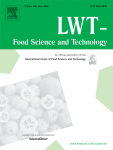Ver ítem
- xmlui.general.dspace_homeCentros Regionales y EEAsCentro Regional Mendoza - San JuanEEA MendozaArtículos científicosxmlui.ArtifactBrowser.ItemViewer.trail
- Inicio
- Centros Regionales y EEAs
- Centro Regional Mendoza - San Juan
- EEA Mendoza
- Artículos científicos
- Ver ítem
Impact of micro-oxygenation timing and rate of addition on color stabilization and chromatic characteristics of Cabernet Sauvignon wines
Resumen
The presented study evaluated anthocyanins, anthocyanin-derived pigments and chromatic characteristics of six micro-oxygenation treatments resulting from applying oxygen at different times and rates. Oxygen was applied before malolactic fermentation (MLF) at a rate of zero or 20 mg O2/L/month and after MLF at rates of zero, 4.5 or 9 mg O2/L/month. LC-MS analysis after 6 months of bottle aging indicated that the formation of anthocyanin-derived compounds
[ver mas...]
The presented study evaluated anthocyanins, anthocyanin-derived pigments and chromatic characteristics of six micro-oxygenation treatments resulting from applying oxygen at different times and rates. Oxygen was applied before malolactic fermentation (MLF) at a rate of zero or 20 mg O2/L/month and after MLF at rates of zero, 4.5 or 9 mg O2/L/month. LC-MS analysis after 6 months of bottle aging indicated that the formation of anthocyanin-derived compounds was related to the acetaldehyde (ACH) levels. When observing an increase in the level of ACH, formation of compounds was enhanced in which ACH was involved as B-type vitisins. Otherwise, where ACH was not involved, compounds as A-type vitisins, pinotins and direct adducts, were formed. Although the wine was filtered after MLF, only a marginal increase in the ACH concentration was observed during post-MLF MOX. This increase occurred only in wines that had previously received pre-MLF MOX. When MOX was applied at both moments and highest rates, wines produced a higher yellow color component (b*) and hue (hab) than the rest of the wines. These CIELab parameters were highly correlated with flavanyl-pyranoanthocyanins. These results suggest that in order to stabilize wine color, it is recommended to apply MOX before and after MLF.
[Cerrar]

Autor
Catania, Anibal Alejandro;
Lerno, Larry;
Sari, Santiago Eduardo;
Fanzone, Martín Leandro;
Casassa, Luis Federico;
Oberholster, Anita;
Fuente
LWT - Food Science and Technology : 111776 (Available online 22 May 2021)
Fecha
2021-05
Editorial
Elsevier
ISSN
0023-6438
Formato
pdf
Tipo de documento
artículo
Palabras Claves
Derechos de acceso
Embargado
 Excepto donde se diga explicitamente, este item se publica bajo la siguiente descripción: Creative Commons Attribution-NonCommercial-ShareAlike 2.5 Unported (CC BY-NC-SA 2.5)
Excepto donde se diga explicitamente, este item se publica bajo la siguiente descripción: Creative Commons Attribution-NonCommercial-ShareAlike 2.5 Unported (CC BY-NC-SA 2.5)

